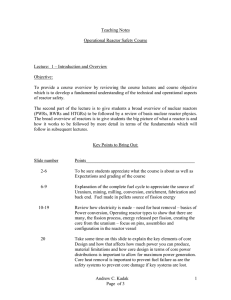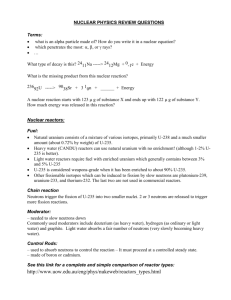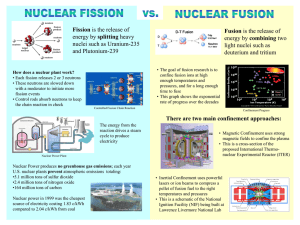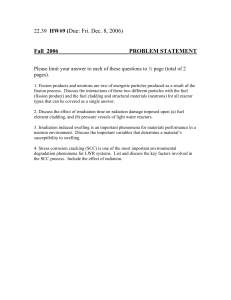Nuclear Energy Nuclear Reactor
advertisement
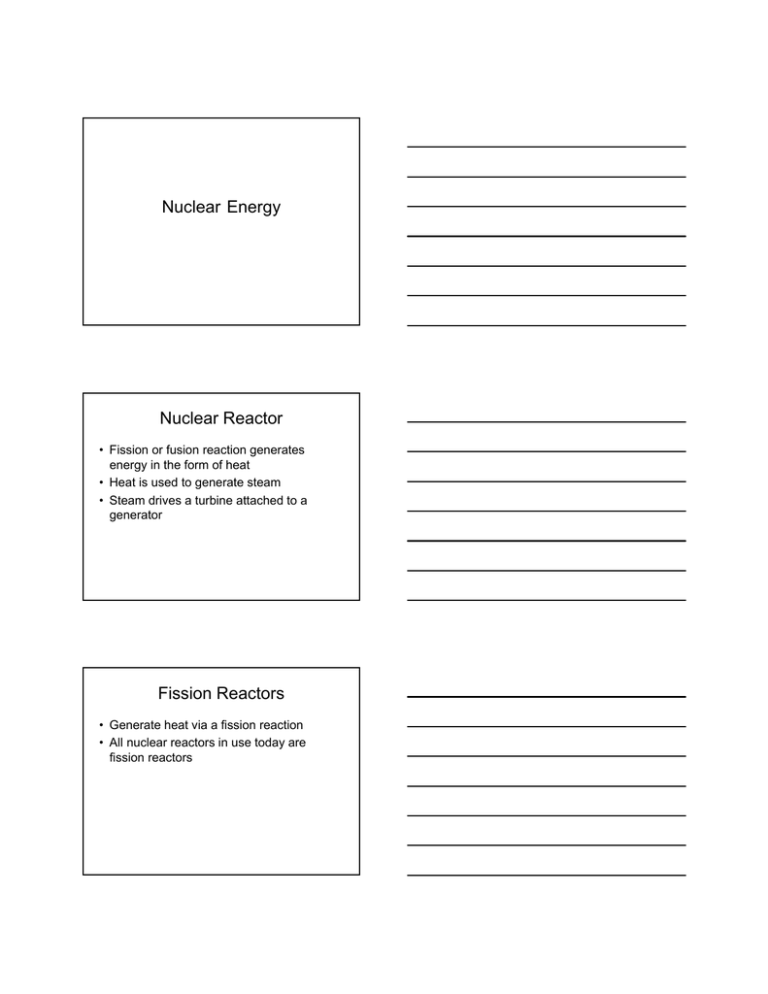
Nuclear Energy Nuclear Reactor • Fission or fusion reaction generates energy in the form of heat • Heat is used to generate steam • Steam drives a turbine attached to a generator Fission Reactors • Generate heat via a fission reaction • All nuclear reactors in use today are fission reactors Critical Reaction • To generate heat, a continuous chain of fission reactions must take place • One fission reaction is – 235U + n → P1 + P2 + 2.3n • When the reaction occurs more neutrons are released so that more reactions can occur resulting in the necessary chain reaction • When the reaction is self sustaining, it is said to be critical Fuel Type • Enriched uranium – Natural uranium (mostly 238U) is enriched with 235U until the fuel contains 2-4% Uranium-235 – Enrichment process is expensive and could be used to produce weapon grade uranium (highly enriched) • Natural Uranium – Used in CANDU reactors – Requires special moderation Moderator • The neutrons released from the reaction are travelling too fast to generate a fission reaction • They must be slowed down • This is done with a moderator – Water, heavy water Control Rods • Some method must be necessary to control how many reactions occur • Most reactors use control rods of some shape or form • These control rods are made of a material that absorbs neutrons • Fewer neutrons means fewer reactions and thus less total energy output Coolant • The fission reaction generates heat • A coolant is needed to remove the heat from the reaction chamber and transfer it a steam generator – The method of cooling and steam generation depends on the type of reactor – Most reactors use either light or heavy water as the coolant Types of Fission Reactors • • • • • • Pressurized Water Reactor (PWR) Boiling Water Reactor (BWR) Pressurized Heavy Water Reactor (PHWR) Reaktor Bolshoy Moshchnosti Kanalniy (RBMK) Gas Cooled Reactor (GCR) Liquid Metal Fast Breeder Reactor (LMFBR) – Lead Cooled and Sodium Cooled PWR BWR CANDU CANadian Deuterium Uranium Heavy Water Moderation • D2O • Heavy water is a better moderator than light water – Better at slowing down the neutrons released from the fission reaction • This allows the use of natural uranium as the fuel Coolant • CANDU reactors also use heavy water as the coolant Reactor Control • CANDU reactors use control rods made of cadmium • The rods are partially inserted into the moderator tank (calandria) • The amount of the rod inserted into the calandria can be adjusted Safety Features • The control rods can be inserted in all of the way – Absorbs all of the neutrons • Liquid poison injection – Liquid that absorbs neutrons • The calandria can be drained – Without a moderator, the neutrons will not be slowed down, and therefore will not react RBMK GCR Scottish Nuclear LMFBR Argonne National Laboratory Argonne National Laboratory Comparing Reactor Types Fusion Reactions Fusion Reactors • Generate heat via a fusion reaction • No production reactors • The Tore Supra tokamak in France holds the record for the longest plasma duration time of any tokamak: 6 minutes and 30 seconds Fuel • Research is being done with hydrogen isotopes (deuterium, and tritium) d t n (17.6 MeV ) p t (4.1 MeV ) d d 3 He n (3.2 MeV ) Containment • Recall that the fuel must be heated to extremely high temperatures to overcome the electrostatic repulsion between the nuclei • At these temperatures the substance becomes a plasma • There are two ways being considered to contain that plasma – Magnetic confinement – Inertial confinement Magnetic Confinement • Magnetic and electric fields are used to heat and squeeze the plasma • Microwaves, electricity and neutral particle beams from accelerators heat a stream of hydrogen gas turning it into plasma • This plasma gets squeezed by superconducting magnets, thereby allowing fusion to occur • The most efficient shape for the magnetically confined plasma is a donut shape (toroid). Inertial Confinement • Laser beams or ion beams are used to squeeze and heat the hydrogen plasma • 192 laser beams will focus on single point in a 10 m diameter target chamber called a hohlraum • At the focal point inside the target chamber, there will be a pea-sized pellet of deuterium-tritium encased in a small, plastic cylinder • The power from the lasers (1.8 million joules) will heat the cylinder and generate X-rays • The heat and radiation will convert the pellet into plasma and compress it until fusion occurs • The idea is that multiple targets would be ignited in succession for sustained heat generation Cold Fusion • Pons and Fleischmann (1989) claimed to have generated fusion at room temperature – Results could not be replicated – There are theoretical reasons as to why it shouldn’t work – None of the products of d+d fusion were ever detected Atomic Bomb • In the early 1940s Hitler banned the sale of Uranium from the Czech mines he had taken over • Einstein wrote a letter to President Roosevelt informing him that nuclear fission could be used for a bomb and that Germany may have already begun development on one • The Manhattan project was started in the town of Los Alamos under the direction of J. Robert Oppenheimer • A fission bomb relies on the fact that a critical mass of uranium produces a supercritical reaction • An alternate version uses TNT to compress plutonium such that a supercritical reaction occurs • The first fission bomb (Trinity) was tested in July 16, 1945 U.S. Department of Defense U.S. Department of Defense Exposed wiring of “The Gadget,” the nuclear device that exploded as part of Trinity. At the time of this photo, the device was being prepared for its detonation. U.S. Department of Defense But when you come right down to it, the reason that we did this job is because it was an organic necessity. If you are a scientist you cannot stop such a thing. If you are a scientist you believe that it is good to find out how the world works; that it is good to find out what the realities are; that it is good to turn over to mankind at large the greatest possible power to control the world and to deal with it according to its lights and values. (Regarding the atomic bomb project.) — J. Robert Oppenheimer From speech at Los Alamos (17 Oct 1945). Quoted in David C. Cassidy, J. Robert Oppenheimer and the American Century (2009), 214.
